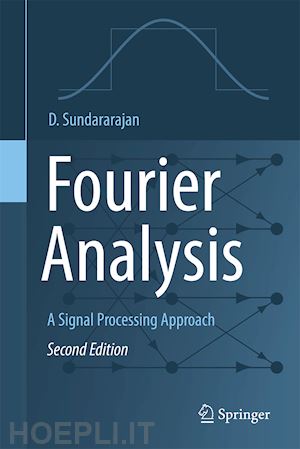

Questo prodotto usufruisce delle SPEDIZIONI GRATIS
selezionando l'opzione Corriere Veloce in fase di ordine.
Pagabile anche con Carta della cultura giovani e del merito, 18App Bonus Cultura e Carta del Docente
This book sheds new light on Transform methods, which dominate the study of linear time-invariant systems in all areas of science and engineering, such as circuit theory, signal/image processing, communications, controls, vibration analysis, remote sensing, biomedical systems, optics, and acoustics. It presents Fourier analysis primarily using physical explanations with waveforms and/or examples, only using mathematical formulations to the extent necessary for its practical use. Intended as a textbook for senior undergraduates and graduate-level Fourier analysis courses in engineering and science departments, and as a supplementary textbook for a variety of application courses in science and engineering, the book is also a valuable reference for anyone – student or professional – specializing in practical applications of Fourier analysis. The prerequisite for reading this book is a sound understanding of calculus, linear algebra, signals and systems, and programming at the undergraduate level.
Review of last version
“The Fourier analysis is mainly presented from a practical point of view, where the mathematical theory is very simplified. This book is mainly written for broad readership of graduate students and researchers in physics, computer science, and engineering with special interest in signal processing. … Doubtless, this textbook will stimulate the practical education in the Fourier analysis and its applications in signal processing.” (Manfred Tasche, zbMATH 1407.94002, 2019)
Chapter 1 Signals.- Chapter 2 The Discrete Fourier Transform.- Chapter 3 Properties of the DFT.- Chapter 4 Two-Dimensional DFT.- Chapter 5 Aliasing and Leakage.- Chapter 6 Convolution and Correlation.- Chapter 7 Fourier Series.- Chapter 8 The Discrete-Time Fourier Transform.- Chapter 9 The Fourier Transform.- Cahpter 10 Fast Computation of the DFT.
Dr. D. Sundararajan holds a B.E. in Electrical Engineering from Madras University and an M.Tech. in Electrical Engineering from the Indian Institute of Technology Chennai (IIT Chennai). He obtained his Ph.D. in Electrical Engineering at Concordia University, Montreal, Canada, in 1988. As the principal inventor of the latest family of discrete Fourier transform (DFT) algorithms, he holds three patents (granted by the US, Canada and Britain). Further, he has published several papers in IEEE Transactions and in the Proceedings of the IEEE Conference, and he is the author of 11 books. He has taught undergraduate and graduate classes in digital signal processing, digital image processing, engineering mathematics, programming, operating systems, and digital logic design at Concordia University, Canada, Nanyang Technological University, Singapore, and Adhiyamaan College of Engineering, India. He has also conducted workshops on digital image processing, MATLAB, and LaTeX.
Over the course of his engineering career, he has held positions at the National Aerospace Laboratory, Bangalore, and the National Physical Laboratory, New Delhi, where he worked on the design of digital and analog signal processing systems.











Il sito utilizza cookie ed altri strumenti di tracciamento che raccolgono informazioni dal dispositivo dell’utente. Oltre ai cookie tecnici ed analitici aggregati, strettamente necessari per il funzionamento di questo sito web, previo consenso dell’utente possono essere installati cookie di profilazione e marketing e cookie dei social media. Cliccando su “Accetto tutti i cookie” saranno attivate tutte le categorie di cookie. Per accettare solo deterninate categorie di cookie, cliccare invece su “Impostazioni cookie”. Chiudendo il banner o continuando a navigare saranno installati solo cookie tecnici. Per maggiori dettagli, consultare la Cookie Policy.